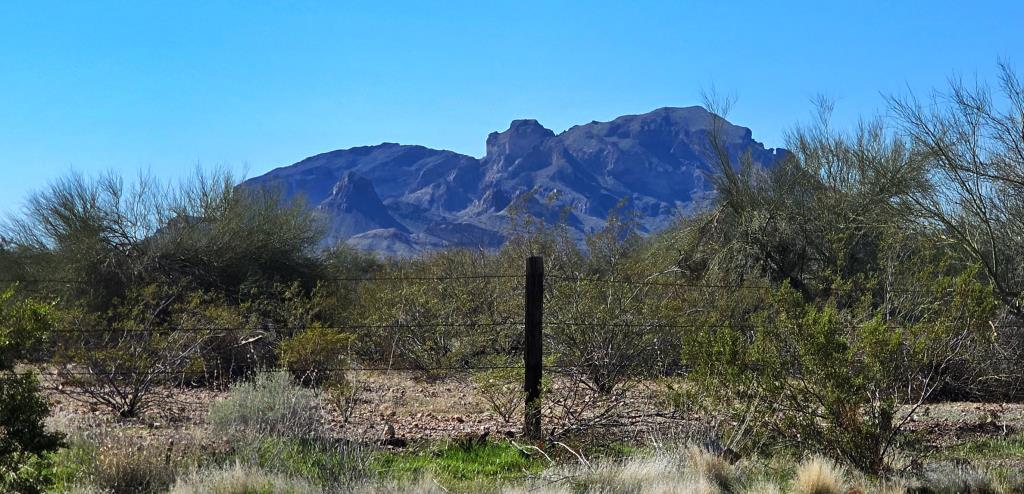| By: Paul S. Cilwa | Viewed: 5/3/2024 Occurred: 2/3/2024 |
Page Views: 371 | |
| Topics: #Autobiography #SaddleMountain #Tonopah | |||
| My first attempt at an easy short hike after starting methyl folate. | |||
Today my friend Arthur and I, staying at the Tonopah hot springs, decided to take a break from soaking and visit nearby Saddle Mountain. That's west of the hot spring. I haven't driven out there in maybe 20 years, but it's been two weeks since I started taking methyl folate, and I feel so good I wanted to stretch my legs a little.
On our way we passed the infamous Hickman's chicken ranch that provides the smells that periodically permeate Tonopah. The egg factory in Tonopah is owned by Hickman's Family Farms, the largest egg producer in Arizona. The factory, which arrived in Tonopah in 2014, consists of 14 enormous barns that house millions of hens. The barns are 560 feet long, 82 feet wide, and 30 feet tall. The arrival of the factory and the hens brought a significant change to the rural, unincorporated community, both increasing the number of local jobs and decreasing the quality of life for them and their families. Since its establishment, residents and businesses have tried to fight back against Hickman's due to the stinging stench of chicken poop and dead birds.

The mountains around Tonopah, including Saddle Mountain, are part of the geologic Basin and Range Province, which underwent moderate to severe Tertiary extension and magmatism. These mountains showcase a variety of geologic layers, including basalt and basaltic andesite lava flows, cinder cones representing volcanic vents, and ash-flow and fallout tuffs with monolithilogic breccia and andesite flows. The end result is striking and sometimes brilliant geologic layers that make them look like works of art.


Saddle Mountain is a distinctive landform with a rich geologic history. It’s part of the Sonoran Desert subdivision of the Basin and Range physiographic and tectonic province, which underwent moderate to severe Tertiary extension and magmatism. The mountain is a volcanic upthrust, showcasing basalt and basaltic andesite lava flows, cinder cones representing volcanic vents, and ash-flow and fallout tuffs with monolithilogic breccia and andesite flows. The mountain's 1,500-foot high cliffs and towering spires are the visible remains of a major volcanic vent from approximately 20 million years ago.

A cinder cone, also known as a scoria cone, is a steep conical hill of loose pyroclastic fragments, such as volcanic clinkers, volcanic ash, or scoria, that has been built around a volcanic vent. These pyroclastic fragments are formed by explosive eruptions or lava fountains from a single, typically cylindrical, vent.



Saddle Mountain offers dispersed camping opportunities. Many sites for primitive camping are available off W. Courthouse Rd. and W. Salome Rd. The area is known for its quiet and beautiful surroundings, making it a popular spot for campers.



Years ago, I went on a nude hike to Saddle Mountain's saddle. I do not recommend nude hiking in Arizona; it's too prickly. I came home with a scraped butt from wriggling down a rock.


My friend, Arthur, appreciates the wilderness.


Although I didn't attempt to climb the mountain, I was able to explore a few short trails for the first time in two years. I am crediting the methyl folate, but also I did have a cortisone shot applied to my troublesome right hip, and that is definitely also helping. Plus, I got to experiement with my floating camera for the second time since I got it!

Can you drive a Tesla in a wilderness area like this? Well, I did. But the Tesla has an admittedly low clearance, so I had to position my wheels on the ridges between the ruts to avoid scraping rocks on the bottom of the car battery (which is the entire bottom of the vehicle).


The power lines come from the nearby Palo Verde nuclear power plant.

So by 2 o'clock we had returned to the hot spring.

Arthur was tickled especially by the guinea hens…

And by this poor peacock, who is constantly trying to hook up with the completely disinterested guinea hens.

And this is Peaches, a very mellow monster of a hog who assists in cleaning up the garbage left by careless campers and soakers.


Okay, enough sightseeing. Time for more soaking!





